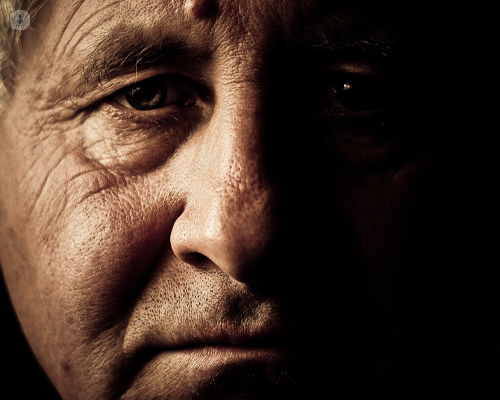Oral cancer symptoms, diagnosis and treatment in detail
Autore:Research has found that oral/mouth cancer is starting to affect more and more people, so much so that it has become a global health issue. It grew to the point that, in 2005 it made up two per cent of all cancers in the UK. It is estimated to follow cervical and stomach cancer as the third most common malignancy in developing countries.
Head and neck reconstructive surgeon, Mr Nicholas Kalavrezos, highlights this condition by considering the symptoms, diagnosis and treatment of oral cancer for those people concerned about this condition.

What is oral cancer and which age group does it affect?
The mucosal lining (squamous epithelium) of the oral cavity is where cancer of the mouth originates. It is a disease affecting mainly people above the age of 55 and around six per cent of oral cancers occur in people under the age of 45. It appears that, in general, the relative survival rate of young people under 45 with oral cancer is high, with a larger amount of people surviving five years and continuing to live over this time, after diagnosis. It’s found that it affects males more than females, too.
Are there any specific risk factors for oral cancer?
Oral cancer is what is known as an ‘environmental disease’. Geographically, there is a significant incidence in these areas:
- Some parts of Western world
- Eastern Europe
- Southeast Asian populations
- Latin America and the Caribbean
- Pacific regions
The mucosal lining of the oral cavity is adversely affected because of the use of substances that cause this. Smoking, alcohol consumption and betel-quid chewing are significant risk factors associated with oral cancer and here are some associated statistics:
- Compared to those who never drink, alcohol drinkers have a five-times higher risk of having oral cancer
- Tobacco smokers are up to six-times more likely to develop oral cancer while the interactive effect of alcohol and tobacco multiplies the chances;
- It is estimated that the combined effects of alcohol and tobacco use contribute to more than two thirds of mouth cancers
What are the symptoms of oral cancer?
Ranging from most common to least, here are the symptoms of oral cavity cancer:
- Non-healing ulcer or sore
- Sore throat, abscess or boil
- Sore tongue or mouth
- Persistent lump or swelling
- White or red patch
- Tooth ache
- Neck swelling
- Lichen planus and/or persistent, hyperplastic oral thrush
- More than one of the above (in most cases)
What is involved in oral cancer diagnosis?
The diagnosis and planning of the treatment of oral cancer is based on two important factors; the exact extent of any tumour and the potential spread to ‘regional’ lymph glands in the neck. Surgeons strive to achieve sufficient ‘cancer-free’ margins because operations are based on the principle of complete tumour removal. Incomplete removal can occur if a surgeon only considers the tumour surface area, without sufficient knowledge of the invasion depth, because tumour mass is a three-dimensional structure.
The typical evaluation of tumour size and invasion pattern/depth is done by computer tomography (CT) or magnetic resonance imaging (MRI). Other procedures take place under specific circumstances:
- Ultrasonography
- Increasingly used for the assessment of the neck status in conjunction with the use of fine needle aspiration cytology (FNAC). This is where a needle is used to collect a small tissue sample for microscopic evaluation
How is oral surgery treated?
Surgery and radiotherapy are the traditional treatment for head and neck cancer. The mainstream treatment for oral cancer continues to be surgery, whilst side effects associated with radical radiotherapy are:
- Dry mouth because of xerostomia (reduced or absent saliva flow)
- Bone and adjacent soft tissue damaged by radiotherapy (osteoradionecrosis) causes the bone to be exposed in the mouth
- Those who have tumours close to the lower jaw are at particularly high risk of experiencing this problem
Surgery may by the single form of treatment in cases of early disease (stage I/II). An intra-oral approach will be taken in the surgical procedure, where there will be a wide local removal of the tumour with a clinical margin of one centimetre of healthy surrounding tissue.
It’s rare that chemo-radiotherapy follows surgery. It will mainly depend on the results of a microscopic examination of the diseased tissue. Even when adjusting for margin status, significant and independent predictors of both local recurrence and overall survival are considered:
- The pattern of invasion of the tumour
- A ‘pushing’ or ‘infiltrative’ tumour front
- Small nerve fibres’ involvement
- Low immune system response
Five-year survival rates (where people are alive to continue for their lives for five years or longer) for early-stage localised disease are over 80 per cent, but this drops to 40 per cent when the disease has spread to the neck. Furthermore, it goes down to 20 per cent for distant metastatic disease (cancer that has spread from the original tumour to distant lymph nodes or organs).
For patients with advanced disease (stage III/IV), treatment becomes more challenging especially when the disease spreads into more than one of the sub-sites of the oral cavity and has, potentially, already spread to the regional lymph nodes. In these cases, the principles surgery will be based on are:
- Adequate tumour removal
- Avoidance of clearly visible skin incisions
- Reconstructive surgery access
Are there factors that affect the choice of oral cancer surgical approach?
Yes. They are:
- Primary tumour site (anterior/lateral/central/posterior)
- Volume and size of the tumour
- How close the tumour is to the lower (mandible) or upper (maxilla) jaw bones
- The tumour’s proximity to the outer skin
The presence of cervical lymph node metastases (the development of secondary malignant growths at a distance from a primary site of cancer) is the most serious independent factor in prognosis of oral cancer, with the exception of distant metastases.
The evolution of neck surgery in recent times has meant that radical surgery has developed into modified radical and selective neck surgery, based on the principal of removal of the lymphatic system in the neck. This means essential structures such as neck muscle/vessels/nerves which haven’t been advertently affected by the spread of the disease, are spared.
Is it possible to have reconstructive surgery after oral cavity cancer?
Considerable defects are caused by substantial surgery to the oral cavity, which will require reconstruction. The aims of reconstructive surgery are:
- Coverage of external wounds
- Stable oral cavity creation
- Bone restoration
- Diet resuming
- Dental restoration
- Cosmetic appearance being restored
The surgical removal of large oral and oropharyngeal tumours is followed by reconstruction that is commonly performed with free tissue and, to a lesser extent, with regional pedicled flaps.
Tissue (referred to as ‘flaps’ or ‘grafts’) are transferred from a different part of the body and placed where the mouth or throat defect is. The transferred tissue’s vital blood supply is guaranteed by the simultaneous transfer of the vascular tree of the graft. Then they are connected with mini surgical sutures to appropriate neck vessels.
Flaps that are used for oral cavity reconstruction can be taken from various body parts. They can include bone as well as soft tissue.
Evolving concepts that contribute to the innovation of head and neck reconstructive surgery are reduction or the morbidity (suffering a disease or medical condition) at the donor site and increased versatility at the recipient site. A safe and reliable procedure in reconstructive surgery following treatment for oral cancer is the use of ‘perforator’ flaps, which are flaps perfused by very small vessels in the outer edges of the body.
Freestyle perforator-flap surgery offers greater freedom in choosing a donor-site area. This is because the flap section is based on the quality and volume of tissue required at the recipient site. It has led to a procedure involving a muscle and nerve-sparing procedure minimising the donor site morbidity, while the versatility allows for easier ‘bending’ and ‘insetting’ in a complex anatomical area like the oral cavity.
Now, functional outcomes of major oral cancer have evolved to the point that patients can eat, drink and speak almost normally without the social exclusions that have affected oral cancer patients in the past. This is because of these advances in modern reconstructive surgery.
References:
- Cancer Research. http://info.cancerresearchuk.org/cancerstats/incidence/commoncancers
- Surveillance epidemiology and end results (SEER) Cancer statistics review 1975-2004. National Cancer Institute. http://seer.cancer.gov/statfacts/html/oralcav
If you are considering oral cavity cancer treatment, Mr Kalavrezos provides leading medical care. Visit his Top Doctors profile to arrange an appointment.


